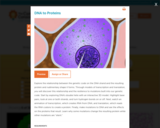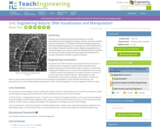
This animation explains how Nettie Stevens research on meal worms unlocked the chromosomal basis of gender.
- Subject:
- Science
- Material Type:
- Lesson
- Provider:
- Cold Spring Harbor Laboratory
- Date Added:
- 08/07/2023

This animation explains how Nettie Stevens research on meal worms unlocked the chromosomal basis of gender.

Explore the relationship between the genetic code on the DNA strand and the resulting protein and rudimentary shape it forms. Through models of transcription and translation, you will discover this relationship and the resilience to mutations built into our genetic code. Start by exploring DNA's double helix with an interactive 3D model. Highlight base pairs, look at one or both strands, and turn hydrogen bonds on or off. Next, watch an animation of transcription, which creates RNA from DNA, and translation, which 'reads' the RNA codons to create a protein.

This online interactive module of 10 pages or frames integrates textual information, 3D molecular models, interactive molecular simulations, and embedded assessment items to guide students in understanding the copying of DNA base sequences from translation to transcription into proteins within each cell. The module divides the exercises in to Day 1 and Day 2 time frames. Teachers can view student assessment responses by assigning the module within a class created within the Molecular Workbench application. This Java-based module must be downloaded to each computer.

このシミュレーションは、バーチャルラボ環境でライゲーション反応の実施を練習する機会を提供します。このプロセスでは DNA リガーゼという酵素を使い、制限酵素消化で得られる相補的な平滑末端または粘着末端を用いて DNA 断片 2 つをつなげます。

이 시뮬레이션은 가상 실험실 환경에서 리게이션 반응 실험을 실습할 수 있는
기회를 제공합니다. 이 과정에서는 제한효소 절단으로부터 생성된 상보적인
평활 말단 또는 점착성 말단을 사용하여 2개의 DNA 단편을 부착하기 위해
효소인 DNA 리가아제를 사용합니다.

This lab video demonstrates how to run a typical protein gel in detail. This method is also called SDS-PAGE and separates proteins by molecular weight.

In this visualization adapted from the University of Massachusetts Medical School, discover the role that dengue viral proteins play in a human cell as the virus prepares to replicate.

Met deze simulatie kunt u een restrictiedigestie oefenen in een virtuele labomgeving. Restrictie-enzymen worden gebruikt om de DNA-strengen van twee plasmiden te knippen; dit levert DNA-fragmenten op met complementaire kleverige uiteinden, die opnieuw kunnen worden samengevoegd om een recombinant plasmide te creëren.

Questa simulazione offre l’opportunità di praticare una digestione da restrizione in un laboratorio virtuale. Gli enzimi di restrizione vengono utilizzati per tagliare i filamenti di DNA di due plasmidi, per produrre frammenti di DNA con estremità coesive complementari che possono essere riassemblati per creare un plasmide ricombinante.

Esta simulação proporciona uma oportunidade de praticar uma digestão por enzimas de restrição em um cenário de laboratório virtual. As enzimas de restrição são usadas para cortar as cadeias de DNA de dois plasmídeos, produzindo fragmentos de DNA com extremidades complementares coesivas que podem ser remontadas para criar um plasmídeo recombinante.

After watching video clips from the Harry Potter and the Goblet of Fire movie, students explore the use of Punnett squares to predict genetic trait inheritance. The objective of this lesson is to articulate concepts related to genetics through direct immersive interaction based on the theme, The Science Behind Harry Potter. Students' interest is piqued by the use of popular culture in the classroom.

This pathway explores the importance of biodiversity and human impact on the environment.

This interactive image allows the user to control the environmental temperature
and observe its impact on the strength of the hydrogen bonds between
complementary strands in a DNA molecule.

Students are introduced to genetic techniques such as DNA electrophoresis and imaging technologies used for molecular and DNA structure visualization. In the field of molecular biology and genetics, biomedical engineering plays an increasing role in the development of new medical treatments and discoveries. Engineering applications of nanotechnology such as lab-on-a-chip and deoxyribonucleic acid (DNA) microarrays are used to study the human genome and decode the complex interactions involved in genetic processes.

Under the "The Science Behind Harry Potter" theme, a succession of diverse complex scientific topics are presented to students through direct immersive interaction. Student interest is piqued by the incorporation of popular culture into the classroom via a series of interactive, hands-on Harry Potter/movie-themed lessons and activities. They learn about the basics of acid/base chemistry (invisible ink), genetics and trait prediction (parseltongue trait in families), and force and projectile motion (motion of the thrown remembrall). In each lesson and activity, students are also made aware of the engineering connections to these fields of scientific study.

This pathway explores innovations in biotechnology that have revolutionized aspects of modern life like agriculture, forensics and medicine.

What is the science behind biotechnology and genetic modification?
Genetic modification (GM) has been practiced for millennia, evolving from simple selective breeding to sophisticated biotechnological methods. Historically, humans transformed wild plants and animals into diverse breeds and crops through selective breeding, as seen in the variety of dog breeds and the transformation of wild grasses into corn. Modern GM techniques now enable the transfer of specific genes between organisms, producing genetically modified organisms (GMOs) that are tailored to resist pests, diseases, and environmental stresses. Today, GM crops are grown worldwide, enhancing food security, reducing pesticide use, and contributing to sustainable agriculture. While nearly 80% of foods in the U.S. contain GMOs, regulatory practices vary globally. The advancements in GM technology promise more affordable food, higher agricultural yields, and reduced environmental impact, reflecting a significant evolution in agricultural practices.
This learning module includes 11 lessons and/or activities.

This video segment from NOVA: "The Killer's Trail" investigates the potential for DNA evidence to solve murder cases, even those from the distant past.

Questa simulazione offre l’opportunità di fare pratica eseguendo una reazione di ligazione in un laboratorio virtuale. Questo processo utilizza l’enzima DNA ligasi per collegare due frammenti di DNA usando estremità complementari smussate o estremità coesive generate dalla digestione di un enzima di restrizione.

Students paticipate in a hands-on lesson discovering how cancer is caused by mutations that accumulate over time.